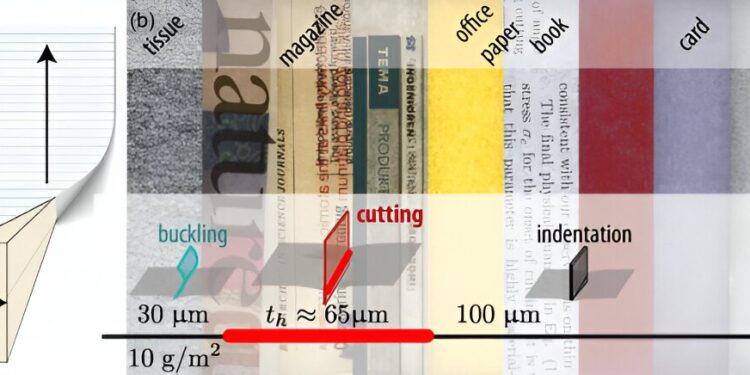The physics of paper cutting. Credit: Physical examination E (2024). DOI: 10.1103/PhysRevE.110.025003
By conducting tests with a skin model, a trio of physicists from the Technical University of Denmark ranked the types of paper most likely to cause a cut. In a paper published in Physical examination ESif Fink Arnbjerg-Nielsen, Matthew Biviano and Kaare Jensen tested the cutting capacity and circumstances involved in paper cuts to establish their rankings.
Paper cuts occur when handling paper products. In addition to the discomfort of sudden blood flow, they are often very painful. In this new study, the researchers noted that most of the research on the topic revolves around infection factors. So they chose to focus on the types of paper most likely to cause cuts, allowing paper users to reduce their risk of injury.
To test the cutting ability of different types of paper, the researchers used ballistic gelatin as a substitute for skin. They then attempted to cut the gelatin using several types of paper. They noted the strength and thickness of the paper, as well as the angles used when cutting.
The research team found that the thinnest paper was unlikely to cause a cut because it tended to curl. Also, thicker paper rarely caused a cut because it had too much surface area. That left paper that was neither too thick nor too thin, such as that used in newspapers or dot-matrix printers, with the two types tied for the title of “most likely to cut skin.”
Other culprits included Post-it notes, printed magazines and office paper. Less likely items to cut included tissues and photo paper. They noted that to cause cuts, the paper had to be tilted slightly.
The researchers also noticed that some papers, such as those used in dot-matrix printers, are particularly effective at cutting. They proved this to be the case by connecting a small piece of paper to a scalpel and using the result as a “paper machete.” They found that their little knife was able to slice through the skin of vegetables and even some meats.
More information:
Sif Fink Arnbjerg-Nielsen et al, Competition between slicing and singeing underlies the erratic nature of paper cuts, Physical examination E (2024). DOI: 10.1103/PhysRevE.110.025003
© 2024 Science X Network
Quote: Paper Types Ranked by Probability of Paper Cuts (2024, August 27) retrieved August 27, 2024 from
This document is subject to copyright. Apart from any fair dealing for the purpose of private study or research, no part may be reproduced without written permission. The content is provided for informational purposes only.



